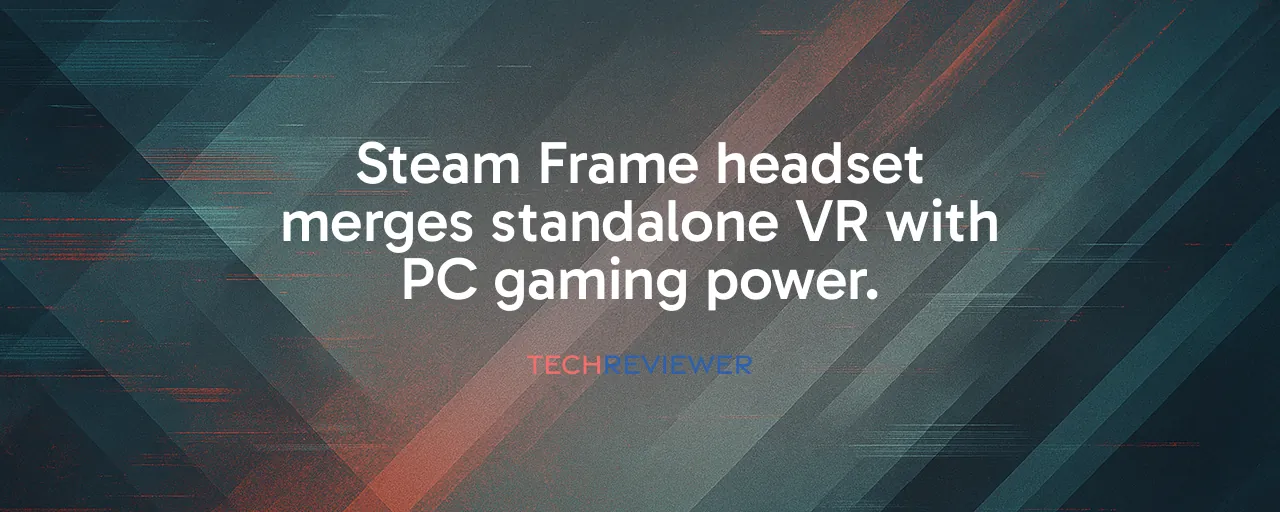A New Era for Virtual Reality
Valve is gearing up to launch its next big thing in virtual reality, the Steam Frame, a headset that promises to bridge two worlds: standalone VR gaming and the raw power of PC-driven experiences. After years of whispers and leaks, the device, codenamed Deckard, has reportedly entered mass production with 400,000 to 600,000 units in the works. If the buzz is true, we could see it hit shelves before 2025 wraps up. The Steam Frame represents Valve's vision for a future where players can switch seamlessly between untethered freedom and high-fidelity gaming.
What makes this headset stand out is its hybrid design. Unlike its predecessor, the Valve Index, which tethered users to a PC and external sensors, the Steam Frame can run games on its own using a modified SteamOS, much like the Steam Deck. Yet, it also supports wireless PC streaming for those craving the graphical punch of a high-end GPU. This flexibility could change how we think about VR, making it both a portable entertainment hub and a powerhouse for immersive titles like Half-Life Alyx.
Tech That Pushes Boundaries
The Steam Frame's specs read like a love letter to VR fans. It is expected to feature high-resolution displays, a significant improvement over the Valve Index's 1440x1600 resolution, though exact specifications have not been officially confirmed. Add in pancake lenses for sharper visuals across a wider field of view, and you've got a headset that minimizes blurry edges and maximizes clarity. Eye-tracking tech takes it further, enabling dynamic foveated rendering, which sharpens only what you're looking at to improve performance without sacrificing quality, though exact performance gains have not been specified.
Then there's the inside-out tracking, ditching clunky external base stations for onboard cameras that map your space. Pair that with new Roy controllers, which are reported to feature a gamepad-style layout with dual thumbsticks and buttons, and you've got a setup that feels intuitive for both VR adventures and virtual flatscreen gaming. Expected to run on a Snapdragon XR2 Gen 2 or Gen 3 processor with WiFi 6E support, the Steam Frame aims to deliver low-latency wireless streaming, making cables a relic of the past. It's a technical marvel, but can it deliver on its lofty ambitions?
Valve Index vs. Meta Quest 2
To understand the Steam Frame's potential, let's look back at two pivotal VR launches. The Valve Index, released in 2019, showed what a premium headset could do when paired with a killer app. Half-Life Alyx, bundled free with the $999 kit, drove 149,000 units sold in 2019 alone, with global stock shortages by early 2020. Its high-res displays and precise lighthouse tracking won over enthusiasts, but the complex setup and steep price kept it niche. Still, it holds a 13.2 percent share of Steam-connected VR headsets in 2025, a testament to its staying power.
Contrast that with the Meta Quest 2, launched in 2020 at $299. Its standalone design and affordable price fueled 20 million units shipped, capturing a massive 86 percent market share in 2023. By removing PC dependency and simplifying setup, Meta brought VR to the masses, though its graphical limits frustrated hardcore gamers. The lesson? Accessibility drives adoption, but enthusiasts crave performance. The Steam Frame aims to split the difference, offering standalone ease with PC-grade power, though its rumored $1200 price could echo the Index's limited reach.
The Catch: Price and Privacy Hurdles
Here's where things get tricky. With a rumored price point approaching $1200, the Steam Frame isn't expected to be cheap. For context, Meta's Quest 3 costs $500, and the Quest 3S is under $300. Valve's banking on enthusiasts willing to pay for premium specs, but that price tag could alienate casual gamers. Plus, wireless PC streaming performs best with a beefy gaming rig and a WiFi 6E router, potentially adding to the cost. Valve's console-style model, selling hardware at a loss to profit on software, worked for the Steam Deck's 5 million units sold, but VR's smaller market makes it a riskier gamble.
Then there's the eye-tracking feature, a double-edged sword. It promises smoother gameplay and intuitive interfaces, but collecting gaze data raises privacy red flags. Research shows eye movements can reveal personal details like interests or even health conditions, creating risks if mishandled. Valve will need clear consent protocols to meet regulations like GDPR and keep users' trust. Balancing innovation with ethical data use will be critical as VR becomes more immersive.
Can Valve Redraw the VR Map?
Valve's Steam Frame arrives at a pivotal moment. The VR market is booming, valued at $14 billion in 2024 and projected to hit $70 billion by 2033, with 216 million active users expected by the end of 2025. Yet, Meta's 50.8 percent market share in Q1 2025 dwarfs competitors like Sony's PlayStation VR2 and Apple's Vision Pro, which struggled at $3499. Valve's hybrid approach could carve out a niche, blending Meta's standalone convenience with the high-end performance HTC and Pimax chase.
But success hinges on content and adoption. Half-Life Alyx proved Valve can deliver must-play titles, but the VR library needs more hits to justify the cost. The Steam Frame's ability to stream flatscreen Steam games could be a game-winner, turning it into a virtual cinema for thousands of titles. Still, barriers like motion sickness, setup complexity for newbies, and social stigma around headsets persist. If Valve nails the balance of accessibility, power, and privacy, the Steam Frame could set a new standard for what VR can be.
